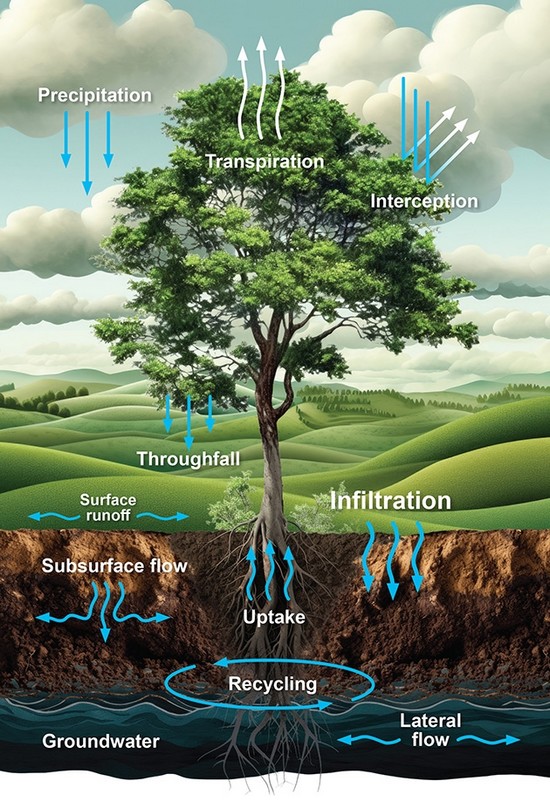Forest sponges: New research reveals how forests absorb water in extreme weather
For immediate release
9 June 2023
New research is showing how effective forests are at mitigating the effects of extreme rainfall during severe weather events.
High resolution data collected from Mahurangi Forest near Auckland during the Auckland Anniversary weekend floods and Cyclone Gabrielle shows that nearly 60% of the rain that fell during those events was stored within the forest rather than flowing immediately across the ground and into waterways. The forest catchment was in effect acting as a sponge, holding on to water that would otherwise have added to flooding downstream.
The data were collected as part of the Scion-led five-year $13.7 million MBIE-funded Forest Flows research programme, which uses a network of 1717 sensors in 10 forests across the country. The sensors capture data every five minutes, leading to world-leading insights about forest hydrology.
The collaborative programme is led by Scion scientist Dean Meason, who says the analysis is unlocking the mysteries about how water moves through catchments and is being stored, with this year’s extreme weather events providing some unique insights.
“Our network of field sensors, meteorological and hydrological equipment has been collecting data for about two years now. A key part of the Forest Flows research is to understand how water moves through forested catchments during and after weather events that range from light rainfall to heavy storms.
“This type of analysis following extreme weather events hasn’t been done before, or at this scale.”
The sheer volume of data from the enormous number of sensors across the different networks within the Forest Flows programme is the largest of its type globally.
Data from Mahurangi Forest showed that despite the huge volume of water (229 mm) that fell during Auckland Anniversary Weekend and Cyclone Gabrielle, the soil near the surface did not saturate.
Nearly 60% of the rainfall was retained in the catchment (soil, shallow groundwater, and forest canopy), the remaining water made it into the stream flow. Although the storm caused larger streamflows, it would have been even greater without the forest present.
Analysis of this world-leading data is still ongoing, but it is already improving our understanding about how forests respond to extreme weather. In time, this new knowledge will boost our understanding of the site conditions that lead to catastrophic landslides and flooding in forest catchments so authorities and the forestry sector can mitigate any negative downstream effects.
Work is nearing completion to analyse data collected from Titoki Forest in the Tararua District during the same period.
Titoki and Mahurangi forests are the two existing Forest Flows research sites hardest hit during this year’s extreme weather events. Both sites feature erodible soils and have been planted as production forests with radiata pine.

The Forest Flows programme is providing a real-time, blow-by-blow picture rather than having to wait months to retrieve the data. Data is captured across the network every five minutes.
Scion is supported in this research by NIWA, who installed and maintained equipment, and provides ongoing hydrological science expertise. Installations were carried out during 2020 and 2021 at five catchments that provide a rainfall gradient. These sites are remote, spread from Te Oneroa-a-Tōhe in the far north of Northland, to Māwhera on the South Island’s West Coast.
Real-time data from these stations and from sensors operated by Scion, and remote sensing data from the University of Auckland and XERRA combine to provide a world-leading picture of the hydrological processes occurring within planted forests. This will enable accurate predictions of water storage and release for entire catchments, while also providing data on changes in water quality over time.
At Scion, the data is also helping to develop a digital twin for each forest catchment to support future forest and landscape management decisions. The sheer scale of the data being captured requires machine learning and artificial intelligence to provide advanced analysis.
Ultimately results from the programme, funded by the Ministry of Business, Innovation and Employment (MBIE) will reveal how resilient New Zealand’s planted forests are when faced with floods and drought and how water moving through forests will be impacted by climate change.
ENDS


